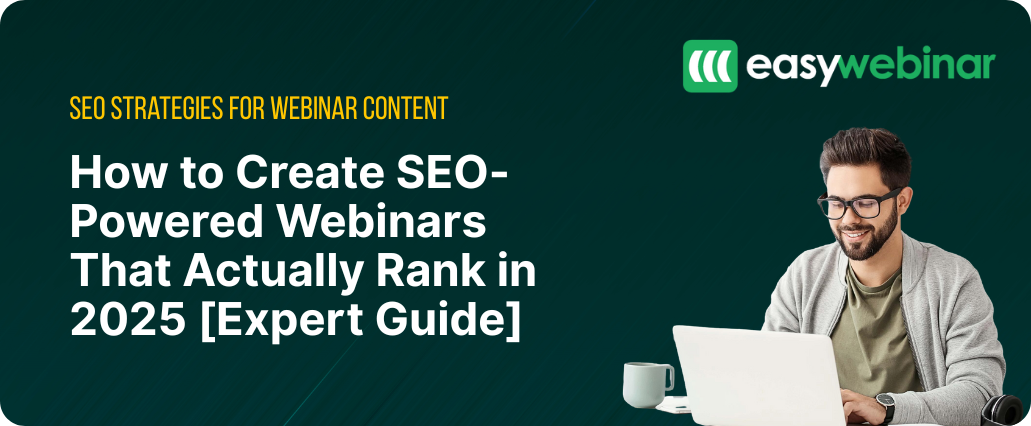How to Create SEO-Powered Webinars That Actually Rank in 2025 [Expert Guide]

Summary :
In 2025, SEO-powered webinars are becoming the gold standard for marketers seeking organic growth and better-quality leads. This guide explores how search optimization transforms webinar performance—from smart keyword research and SEO-optimized landing pages to event schema, backlinking, and content repurposing strategies. You’ll learn actionable techniques to rank your webinars higher in search results, attract the right audience, and maximize replay value with evergreen content. EasyWebinar’s powerful tools make it simple to put these strategies into practice for lasting visibility and lead generation.
Table of Contents
- Why SEO Matters for Webinars in 2025
- Start with Smart Keyword Research
- Optimize Your Webinar Landing Page
- Boost Visibility with Technical and Off-Page SEO
- Turn Your Webinar into Evergreen SEO Content
- Conclusion
- FAQs
SEO webinars have become a significant marketing strategy, and 95 percent of marketers now use them to generate leads. Webinars provide tremendous value, but they remain invisible to potential audiences without proper search optimization.
The numbers tell an interesting story – 76 percent of marketers get better results when they implement SEO strategies for their webinar content. Search Engine Optimization makes a huge difference in both the quantity and quality of traffic that your webinar pages receive from search engines. Webinar SEO needs patience and consistent effort to show results. You can improve organic traffic, boost rankings for relevant keywords, and end up increasing attendance at your online events by implementing proven SEO tactics for webinars.
This piece will show you everything you need to know about creating webinars that rank well in 2025. You’ll find practical steps to reach the widest possible audience through search, from keyword research basics to technical optimization techniques.
Why SEO Matters for Webinars in 2025
The digital world of webinar marketing looks completely different as we head into 2025. Marketers who used to rely only on paid promotion now find that organic search strategies give better long-term results at a much lower cost.
The move from paid to organic webinar promotion
Many marketers tried the organic-only approach for content promotion at first. They soon realized they needed paid advertising to get the results they wanted. All the same, this situation is changing as organic search becomes more valuable for webinar marketing.
People spend about 95 minutes each day scrolling through social media platforms. They see countless pieces of content during this time. Paid ads alone can’t cut through this noise anymore – they’re too expensive and don’t work as well as before. Then businesses find they can’t succeed using either paid or organic promotion by itself.
Smart marketers now blend both approaches and focus more on organic SEO as their foundation. This makes sense for several key reasons:
- SEO creates lasting visibility without ongoing costs
- Organic traffic brings better-targeted audiences
- Search-optimized content generates leads 24/7
- SEO helps reduce paid media costs
Your SEO-optimized webinar content creates a positive cycle. Better visibility attracts more attendees, which tells search engines your content is valuable and boosts your rankings even more.
How SEO boosts webinar visibility and lead quality
SEO makes a huge difference in both the number and quality of people visiting your webinar pages from search engines. It also builds your brand’s credibility and trust without spending money on ads.
Organic search traffic converts better than other sources. Users show more interest in your content. This happens because webinars naturally draw in people who really want solutions. When you optimize for search, you get contact details from attendees who actively look for answers to problems your webinar solves.
This natural selection process gives you higher quality leads compared to cold outreach. These prospects have already spent time with your content, which leads to faster sales cycles and better conversion rates.
A search-optimized webinar registration page ranks better. This helps interested professionals find your event more easily. Search engines need metadata to understand your webinar content, which makes this optimization crucial for effective webinar SEO.
Start with Smart Keyword Research
The success of SEO-powered webinars depends on a full picture of keyword research. You need to understand your audience’s search patterns and position your webinar to match these searches before creating content.
Use tools like Ahrefs, SEMrush, and Google Trends
You need reliable tools that provide complete data to conduct keyword research effectively. Ahrefs has one of the largest keyword databases with 28.7 billion keywords across 217 countries, which makes it perfect to promote webinars globally. Semrush has 26.7 billion keywords with better US coverage (3.6 billion US keywords compared to Ahrefs’ 2.2 billion).
Google Keyword Planner works well for beginners. This free tool helps you “find new keywords, search for words or phrases related to your products or services” and suggests keywords to create stronger campaigns.
Each tool has its strengths. Ahrefs shows traffic potential and SERP position history clearly. Semrush categorizes keyword intent in detail. Google Trends shows live interest patterns that other tools might miss. The best approach is to use these tools together to learn about your keyword landscape.
Group keywords into topic clusters
Your webinars need topical authority, so organize keywords into topic clusters instead of targeting random ones. This method prevents keyword cannibalization and builds stronger SEO foundations.
Here’s how to build effective topic clusters:
- Pick a main “pillar” topic for your webinar
- Discover related subtopics and supporting keywords
- Sort keywords by user intent and search volume
- Create content that connects these topics
Some tools do the grouping automatically. Moz’s Keyword Suggestions creates topic-based clusters that show what to cover and how to arrange your content. Search engines understand your webinar’s topic better with this clustering approach.
Match keywords to user intent
Your webinar’s optimization depends on understanding user searches. Keywords typically fall into three intent categories: informational (learning about a topic), navigational (finding a specific resource), and transactional (ready to take action).
Balance your keyword selection across the content funnel. High-conversion transactional keywords with terms like “buy” or “register” are tempting targets. However, informational keywords often bring more traffic and build awareness.
The search results pages tell you about user intent. The type of content that ranks gives clear signals about what users want.
Include long-tail and SERP keywords
Long-tail keywords work well for webinars. These longer, specific phrases have lower search volume but face less competition and convert better. These keywords often show your audience’s specific questions, which you can address in your webinar.
Here’s how to find valuable long-tail keywords:
- Look for keywords with 3+ words and lower search volumes (0-1,000)
- Search for question-based keywords
- Review Google’s “People also ask” boxes
- Check your site’s current rankings in Google Search Console
These keyword research strategies help your webinars match your audience’s searches better, which improves your chances of ranking well substantially.

Optimize Your Webinar Landing Page
A webinar landing page is a vital conversion point that turns interested prospects into registered attendees. Search engine optimization of this page will increase its visibility and bring higher-quality leads to your webinar.
Craft SEO-friendly titles and meta descriptions
Meta descriptions help boost click-through rates and show relevance to search engines. Search engines don’t directly use them in ranking algorithms. However, they benefit SEO by improving CTR, which Google uses to determine result quality.
Your meta descriptions should:
- Stay under 155 characters
- Use active voice with clear call-to-action
- Put your focus keyphrase near the beginning
- Match your page content accurately
Your SEO title needs to do two things: help you rank for your target keyword and make users want to click through to your page. The best results come from placing your keyphrase at the start of the title.
Use primary keywords in headers and body content
Keywords placed throughout your landing page content boost search visibility. Your page’s ranking on Google’s SERP improves when you add relevant keywords to the title, description, and body content. Keywords should appear in:
- H1 tag (main headline)
- H2 and H3 subheadings
- Body copy
- Internal links
Add structured data and event schema
Event schema markup helps search engines understand your webinar details. This makes your event eligible for enhanced display in Google Search results. Such structured data can double your visibility compared to typical year-over-year growth.
The essential properties include:
- name (webinar title)
- startDate and endDate
- location (virtual location with URL)
- organizer information
Include a clear CTA and EasyWebinar registration form
EasyWebinar’s registration system lets you customize forms to match your brand while getting essential attendee information. Simple registration forms that ask for minimal information typically convert better.
Your CTA should stand out with contrasting colors and compelling text. Tailored CTAs convert 202% better than default versions, which makes customization worth the effort.
Add an FAQ section with keyword-rich answers
FAQ sections handle potential objections early and boost your SEO. Questions keep visitors on the page longer and reduce bounce rates.
Your FAQ section should:
- Feature questions with target keywords
- Give clear, brief answers
- Handle common concerns about your webinar topic
- Group questions by category for easy navigation
Schema markup for your FAQs and natural keyword placement in questions and answers maximizes SEO benefits. This approach makes your content more visible to search engines while giving valuable information to potential attendees.
Boost Visibility with Technical and Off-Page SEO
Technical SEO factors can make or break your webinar’s search visibility, whatever the quality of your content. These optimizations will give your valuable webinar content the widest possible reach.
Ensure mobile responsiveness and fast load times
Mobile devices generate over 60% of website traffic, and about 25% of webinar attendees join from mobile platforms. Mobile optimization isn’t optional anymore. Start by implementing a viewport meta tag so your webinar pages display correctly on all devices. Next, compress images, simplify animations, and streamline registration processes to speed up load times. Google prioritizes mobile-first indexing, so these technical improvements directly boost your search rankings.
Build backlinks through guest posts and PR
Backlinks work like digital endorsements that tell search engines your webinar content has value. Sites with more high-quality backlinks typically rank higher in search results. Here are some proven strategies:
- Guest posting on relevant industry sites helps showcase your expertise and earn valuable links
- Publishing press releases about your webinar through reputable media outlets
- Working with industry experts who can share and link to your webinar content
Note that a single high-authority backlink could be worth more than dozens of low-quality ones.
Promote on social media with keyword-rich captions
Social media promotion gives your SEO an indirect boost by increasing traffic and engagement. You should create different content formats for social sharing—carousel posts, video teasers, audiograms, and infographics. Add keyword-rich captions and relevant hashtags to these visuals to increase visibility. Your employees’ advocacy can expand reach without extra ad spending.
Use internal linking to related blog posts or past webinars
Internal links build structure within your site and share authority with important pages. Pages with strong internal linking often get five times more traffic. Link your webinars from relevant blog posts, related webinar content, and high-traffic pages. Google uses these internal links to find new pages and identify your most important content. This approach helps your webinar rank better in search results.

Turn Your Webinar into Evergreen SEO Content
Smart webinar creators know a single event can propel development of SEO content for months. Content marketers who repurpose their material are 2.5x more likely to succeed. Use EasyWebinar to create evergreen webinars since 63% of viewers watch recordings instead of live sessions.
Embed the on-demand webinar on a blog page
The recording should be embedded on your site after your live webinar ends. Pages that feature videos keep visitors on site longer and boost your SEO performance. EasyWebinar makes your recording available right after broadcast. Blog embeds work best – some companies see over 50% of their on-demand webinar views coming from blog posts.
Add a full transcript and summary with keywords
Webinar transcripts provide amazing SEO benefits. Search engines prefer text, which helps you rank higher and brings more traffic. The transcripts also make your content available to everyone, including viewers with hearing impairments. You should add target keywords strategically throughout your transcript to improve searchability.
Use EasyWebinar’s replay features to get long-term traffic
EasyWebinar lets you send recordings to people who missed the live event. Note that a short viewing window of 2-3 days creates urgency and encourages quick viewing. Replays serve as your campaign’s final push to address sales questions and use lack of availability to drive conversions.
Repurpose into blog posts, guides, and social snippets
A single webinar can become many content pieces:
- Convert key segments into blog posts using webinar transcripts
- Pull memorable quotes for social media posts
- Create downloadable guides or ebooks on specific topics
- Develop an FAQ from audience questions for search visibility
Your webinar becomes a content engine that powers your SEO efforts around the clock.
Conclusion
SEO-powered webinars give marketers a great chance to succeed in 2025. Many businesses still depend on paid promotion. But organic search strategies now bring better, lasting results at lower costs. Making your webinars SEO-friendly isn’t optional anymore – it’s vital to stand out in today’s digital world.
Your webinar’s SEO success starts with solid keyword research. These insights help optimize landing pages through compelling titles, smart keyword placement, and structured data. Mobile responsiveness and backlink building are the foundations of boosting your webinar’s visibility.
The real magic happens after your live event ends. Your webinar can work harder by turning it into different content types – transcripts, blog posts, and social snippets. This creates a content ecosystem that brings traffic and leads 24/7.
Moving from paid-only to organic webinar promotion makes sense. SEO creates lasting visibility without ongoing costs. Organic traffic usually converts better than other sources because these visitors actively look for solutions your webinar offers.
EasyWebinar provides tools to put these SEO strategies into action. The platform’s customizable registration forms and automatic replay features help create search-optimized webinar experiences. These features attract qualified attendees and rank well. Start using these SEO tactics now to help your valuable webinar content reach more people through search.
FAQs
Q1. How can I optimize my webinar for search engines in 2025?
To optimize your webinar for search engines, start with thorough keyword research using tools like Ahrefs or SEMrush. Incorporate these keywords into your webinar title, description, and landing page content. Use structured data and event schema to help search engines understand your webinar details. Ensure your landing page is mobile-responsive and loads quickly. After the webinar, repurpose the content into blog posts, guides, and social media snippets to create evergreen SEO content.
Q2. Is SEO still important for webinars in 2025?
Yes, SEO remains crucial for webinars in 2025. As organic search strategies deliver more sustainable results at a lower cost compared to paid promotion, implementing proper SEO tactics for webinars is essential for standing out in the competitive digital landscape. SEO helps improve webinar visibility, attract higher-quality leads, and generate long-term traffic without recurring costs.
Q3. What is the best way to conduct keyword research for webinars?
The best approach to keyword research for webinars involves using tools like Ahrefs, SEMrush, and Google Trends to identify relevant keywords. Group these keywords into topic clusters to establish topical authority. Match keywords to user intent (informational, navigational, transactional) and include long-tail and SERP keywords. This comprehensive approach ensures your webinar content aligns closely with what your audience is searching for.
Q4. How can I turn my webinar into evergreen SEO content?
To transform your webinar into evergreen SEO content, embed the on-demand recording on a blog page on your website. Add a full transcript and summary with relevant keywords. Use replay features to drive long-term traffic. Repurpose the webinar content into various formats such as blog posts, downloadable guides, and social media snippets. This strategy creates a content ecosystem that continues to drive traffic and generate leads long after the live event.
Q5. What technical SEO factors should I consider for my webinar landing page?
For your webinar landing page, ensure mobile responsiveness and fast load times, as over 60% of website traffic comes from mobile devices. Implement structured data and event schema to enhance search engine understanding of your webinar details. Use clear calls-to-action (CTAs) and optimize your registration form. Include an FAQ section with keyword-rich answers to address potential attendee questions and improve SEO. These technical optimizations significantly impact your webinar’s search visibility and user experience.